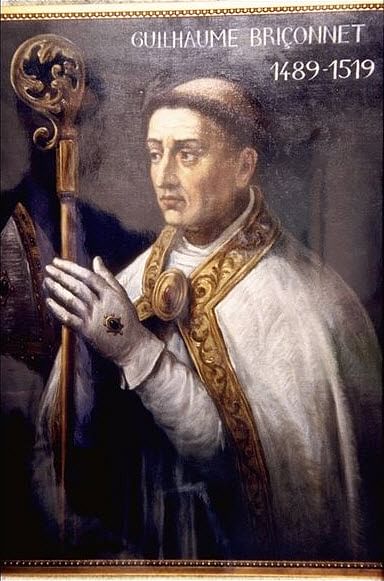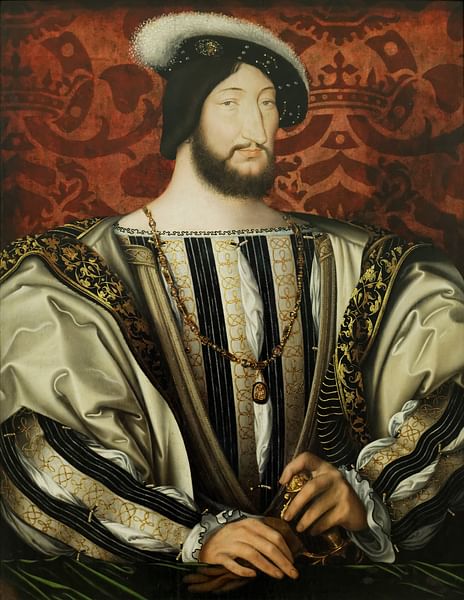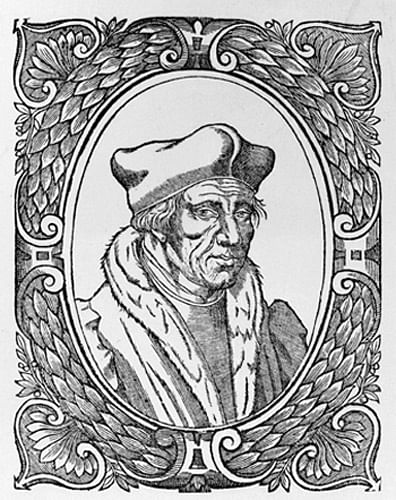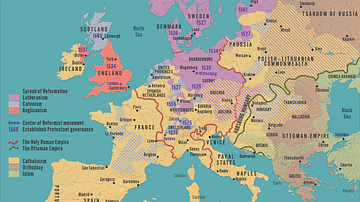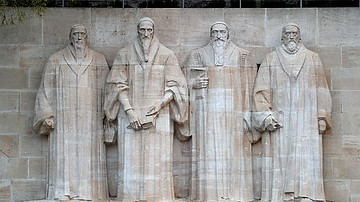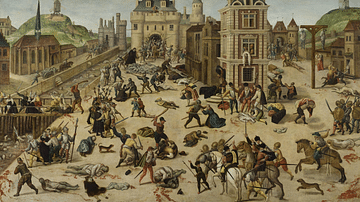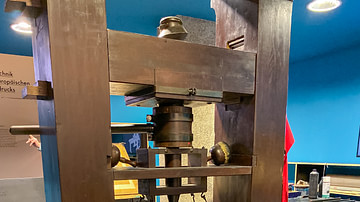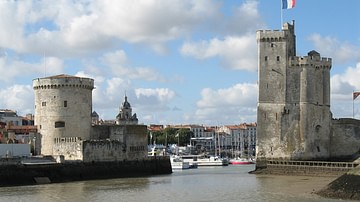As the Protestant Reformation emerged in France in the early 16th century, the city of Meaux became one of the first centers of controversy. Bishop Guillaume Briçonnet II undertook a campaign to reform the Catholic Church from within and called Lefèvre d'Étaples, a leading figure in French humanism, to lead missionary efforts. Soon they found themselves at odds with the Catholic hierarchy.
Reformation
Until the 16th century, local reform movements and peasant revolts were easily suppressed. The Inquisition, instituted in 1231 by Pope Gregory IX (served 1227-1241), had largely succeeded in stamping out heresy. With the invention of the printing press in the 15th century, preventing the circulation of novel ideas became more difficult. After Martin Luther's protest in Wittenberg against indulgences in 1517 with his Ninety-Five Theses, his teachings began to circulate widely in France. In the city of Meaux, William Farel (l. 1489-1565) and the Leclerc brothers contested the veneration of Mary and the saints. They provoked the ire of the Faculty of Theology (Sorbonne) in Paris and drew growing hostility from parliamentarians. Farel was considered especially dangerous because of his opposition to the dogma of purgatory. Their followers were soon called Lutherans even if they had little contact with the German Reformation; Lutherans were anyone suspected of heresy.
Briçonnet II & King Francis I
Bishop Guillaume Briçonnet II (l. 1472-1534) entered Meaux in 1516 as bishop with great concern for the ecclesiastical problems of the Church. He was made bishop of Lodève in 1489 at the age of 17 and had followed in the steps of his father, Cardinal Briçonnet (l. 1445-1514), who left Rome in 1510 with four other cardinals to launch reforms in the Church in opposition to Pope Julius II (served 1503-1513). Briçonnet II became a confidant of King Francis I (r. 1515-1547) whose religious positions fluctuated between his counselors and his sister Marguerite of Navarre, who was sympathetic to Reformed teaching. Francis I, however, was most preoccupied with his royal authority and the burdens of decades of warfare. He was favorable to the spirit of the Renaissance but opposed to the moral rigorism of reformers within the Church.
Shortly after his enthronement in 1515, Francis I sent Briçonnet II to Rome to negotiate the Concordat of Bologna in 1516 with Pope Leo X (served 1513-1521). The Concordat removed the French Church's traditional rights of election and granted the king the authority to make appointments to major ecclesiastical positions. Both the high clergy and nobility were placed under the king's control. He was able to reward his most faithful servants by offering them abbeys, bishoprics, titles, and other benefits. The Concordat encountered opposition and might have pushed some clergy toward the Reformation because of questionable appointments. Yet the Concordat accomplished Francis I's aim to attach French royalty to the Catholic Church and guaranteed a Catholic monarchy.
Briçonnet inherited a bishopric similar to many others in France. People panicked at the thought of dying without the last rites, and there was little knowledge of the Holy Scriptures among the peasantry. The Virgin was solicited for all their needs, each saint had its specialty, and sacred relics imported from the Holy Land after the crusades were treated as talismans. The naïve faith of the people was largely the fault of a poorly-trained clergy that did not provide serious religious instruction. The new bishop had taken note of these deficiencies in his diocese and set out to correct them. In 1518, he hired preachers and sent them throughout his parishes to evangelize Catholics who had fallen away from the Church in their commitment to religious observances. A year later, with discouraging results, Briçonnet decided to train new priests and pursue his project of reform. He held the conviction that the reformation of customs and mores was useless apart from a transformation of the inner person. To that end, he turned to Lefèvre d'Étaples of Picardy.
Lefèvre d'Étaples
Jacques Lefèvre d'Étaples (l. 1450–1537) taught philosophy at the University of Paris from 1490 to 1508 where he first came into contact with the Briçonnet family. In 1521, Briçonnet II invited him to Meaux to spearhead reformation initiatives within the Catholic Church. As a result of Lefèvre's activities and teaching, Meaux became the principal place of activity for the 'evangelicals' and a group known as the Circle of Meaux. Lefèvre was passionate about bringing the Scriptures to everyone in their language. In the eyes of some, however, he appeared factious and dangerous and was surveilled by his adversaries. He raised the question on which all future reformers would take a position – the relationship between faith and works in the justification of sinners. He exhorted Christians to read and meditate on the Gospels and opposed the Church's position that commoners could never sound the sublime depths of scripture. On this essential point, the Catholic Church and different streams of Reformation thought radically diverged. For the Church, doctrinal truth resided in scripture and dogmas established by tradition. For the reformers, doctrinal truth resided in scripture alone and every believer had the right and the duty to search and understand its truths.
Although adversaries at the Faculty of Theology of Paris treated Lefèvre with contempt, the opposition did not stop Parisian students from visiting Meaux. There were other notable visitors at Meaux such as Marguerite of Alençon (l. 1492-1549) and her queen mother, Louise of Savoy. Marguerite, sister of Francis I, who later became queen of Navarre in 1527, was known as the guardian angel of the evangelicals. Her poetry testifies to her spiritual sensitivity and was accompanied by her charitable works. She ardently desired the reform of the Church she loved. Even when criticized by the Faculty of Theology, she guarded the hope of a reform wrought at the interior of the Church.
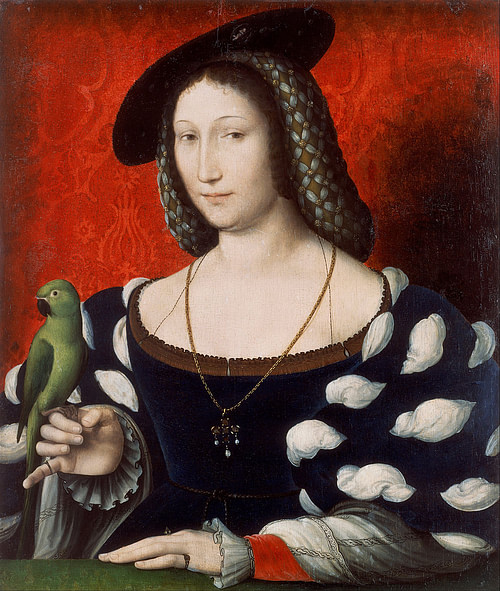
Despite impediments from the Faculty of Theology, and under royal protection by Marguerite, the writings of Lefèvre were widely diffused. He and the Circle of Meaux engaged in their missionary work throughout the region. They argued for a return to apostolic teaching and denounced the veneration of saints and the sale of indulgences. His Commentaries on the Four Gospels appeared around 1522. He also translated the New Testament and Old Testament into French. Lutheran teachings were condemned by the Faculty of Theology in 1521, which placed the school at Meaux under suspicion and opened the way for an era of violence.
Briçonnet's Dilemma
Bishop Briçonnet could not ignore the excommunication of Luther by Pope Leo X in 1521. He understood that he needed to distance himself from people and events associated with the German Reformation. Friends of Lefèvre defected and returned to the teaching of the Church. While Briçonnet did not wish to end his efforts of reform and continued his mission to print and distribute the Scriptures in French, he decided to publicly condemn Luther to avoid his own condemnation. In October 1523, to placate the Faculty of Theology, Briçonnet issued edicts that forbade the sale, possession, or reading of Luther's writings. The people of Meaux were not deterred by these repressive measures and showed even more interest in the new teachings. In response, Briçonnet's adversaries began a violent campaign against the bishop in 1524. Posters were hung from the cathedral and plastered on walls throughout Meaux attacking Briçonnet as a Lutheran.
In December of that same year, Briçonnet was called upon to post papal bulls of Pope Clement VII (served 1523-1534) which included the announcement of new indulgences and a three-day fast for forgiveness. The people of Meaux ripped down the papal bulls and reviled the pope as Antichrist. The city entered into a state of rebellion against the Church and royal officials now had the pretext to justify repression. In the absence of Francis I, a prisoner of Charles V, Holy Roman Emperor (r. 1519-1558), after France's defeat at the Battle of Pavia in February 1525, the first persecution was unleashed. At Meaux, Briçonnet acted in vain to calm the spirits. He instructed the priests to read prayers once again for the dead and to invoke the Virgin and saints, and he took under his protection the statues and images of saints. The warnings of the bishop were no longer respected by the people; the time of martyrs arrived, and the time of revolt.
Repression
Jean Leclerc was arrested at Metz for destroying statues, had his right hand cut off, and suffered other tortures before being burned alive as he recited the Psalms (Miquel, 58). The news spread, the search for heretics intensified, and the Circle of Meaux was warned that they no longer enjoyed official protection. More arrests followed, and Lefèvre fled in exile to Strasbourg. At Meaux, the rebellion continued and the stories of martyrs served as fodder for sermons. In 1528, a large crowd gathered at the cathedral and posted a bull allegedly signed by the pope to the glory of Luther. Briçonnet was scandalized by this provocation and searched for the authors of this outrage. Eight men and women were delivered to him. Six publicly recognized their fault, were condemned, branded with the fleur-de-lys on the forehead, and led through the streets as an example. One recalcitrant, Denys de Rieux, cried aloud that the Mass was a denial of the death and passion of Christ. He was dragged through the streets on a rack before being burned alive.
Briçonnet himself did not escape censure by Parliament for having permitted heresy to propagate at Meaux. Other bishops severely judged the events at Meaux and laid the blame on him. Although Briçonnet had not protected the extremists who sought to abolish the hierarchy, questioned the sacraments, and destroyed statues, he was accused of having permitted the so-called Lutherans to organize and freely express their views. Bishops gathered in 1528 at the Council of Sens and demanded the condemnation and punishment of the heretics at Meaux. The absolute value of all the sacraments, the adoration of Mary and veneration of the saints, and the necessity of good works for salvation were reaffirmed. The bishops reminded the king that his predecessors had not hesitated to use the sword to exterminate heresies. This call to repression was soon answered on 31 May 1528. An anonymous, iconoclastic Parisian cut off the head of a statue of Mary with the baby Jesus in her arms. The king placed a bounty on the head of the perpetrator. The guilty person was not found. Instead, the eminent humanist Louis Berquin (l. 1490-1529), who had already been twice spared from the Faculty of Theology's condemnation by the king's intervention, was arrested and burned at the stake. It was the first execution of a person of renown.
Lefèvre and Briçonnet had not been able to preserve the illusion that one could evangelize in a way that called into question the order of the kingdom. Briçonnet died in 1534 without witnessing the martyrdom of the last members of the Circle of Meaux. Lefèvre, for his part, found refuge with Marguerite, queen of Navarre. He died in his sleep, afflicted that he had not merited the fate of those slain for the Gospel that he taught them.
